
1114 WIRELESS FOUR-ZONE
EXPANDER
Installation Guide
Figure 1: 1114 Wireless Expander
The 1114 Wireless Four-Zone Expander
allows up to 4additional hardwired
zones to report wirelessly to the control
panel. Use the four zones with burglary
or other non-powered devices. The
expander is designed to operate on
one CR123A battery or connect to an
optional 12VDC power supply.
Compatibility
• All DMP 1100 Series Panels
• Wireless Receivers v104 and higher
What is Included?
• 1114 Wireless Four-Zone Expander
• 3 V Lithium CR123A battery
• Hardware pack with 470k EOL
Resistors
1
PROGRAM THE PANEL
Refer to the panel programming guide as needed.
1. In ZONEINFORMATION, enter the wireless
ZONENO: and press CMD.
2. Enter the ZONENAME and press CMD.
3. Select the ZONETYPE and press CMD.
4. At NEXTZN?, select NO.
5. Select YES when WIRELESS? displays.
6. Enter the eight-digit SERIAL# and press CMD.
7. Enter the CONTACT number being used.
Note: The 1114 Tamper reports on Contact1 only.
If Contact1 is not programmed into the panel
as a zone, the 1114 cannot report tamper to the
control panel.
8. Enter the SUPRVSNTIME and press CMD.
9. At the NEXTZN? prompt, select YES and
continue to program up to three more zones.
Note: Zones must be entered sequentially. For
example, if you program zone71, you need to
program zone72 as the next contact. Use the
same serial number for each contact.
DESCRIPTION
2
POWER THE DEVICE
Power the device with a 3V lithium battery or a
12VDC power supply. Do not install a battery if the
device is being powered by a power supply. The
power supply does not charge the battery.
CR123A 3V Lithium Battery
Observe polarity when installing the included CR123A
battery.
1. Remove the housing cover.
2. Install the supplied jumper on the two pins next
to BAT on the power source header.
3. Place the battery in the holder and press it into
place.
4. Snap the cover back into place.

2 1114 INSTALLATION GUIDE | DIGITAL MONITORING PRODUCTS
The device provides a Survey LED capability to allow one person to confirm communication with
the wireless receiver or panel while the cover is removed.
1. With the cover removed, hold the device in the exact desired location.
2. Press the tamper switch to send data to the panel and determine if communication is
confirmed or faulty.
CONFIRMED: If communication is confirmed, for each press or release of the tamper switch,
the LED blinks immediately on and immediately off.
FAULTY: If communication is faulty, the LED remains on for about 8seconds or flashes
multiple times in quick succession. Relocate the device or receiver until the LED confirms
clear communication.
SELECT A LOCATION
12VDC Plug-In or External Power Supply
The device can also be powered by a 12VDC
plug-in power supply (e.g. DMP Model 376L) or
a 12VDC external power supply (e.g. DMP Model
505-12). When using a plug-in power supply,
mount the device near a wall outlet.
1. Remove the housing cover.
2. Install the supplied jumper on the two pins
next to EXT on the power source header.
3. Wire the power supply to the DC power
terminals by following the power supply-
specific instructions below.
Plug-In Power Supply
Connect the black wire with the white stripe
to the positive (+) terminal and the solid black
wire to the negative (-) terminal. See Figure2.
Plug the power supply into a 110VAC outlet.
External Power Supply
Using 22AWG wire, connect the DC power
terminal block on the device to the DC power
terminal on the 505-12 power supply PCB.
Observe positive and negative polarity on all
connections. See Figure3.
Snap the cover back into place when you are
finished.
3
Figure 2: 1114 Wireless Expander Side View
Figure 3: Power Supply Connection
+ DC -
505-12 Power
Supply
12 VDC
22 AWG
Wire
DC Power
2-position
Terminal Block
- +
- +
DC
Plug-in
Power
Supply
DC Power
2-position
Terminal Block
- +
- +
Black Wire
with White
Stripe
to Positive
Black Wire
to
Negative

1114 INSTALLATION GUIDE | DIGITAL MONITORING PRODUCTS 3
Locate zone devices within 100feet of the device. Use 22 or 18AWG wire to complete the
connections between zones1-4 of the device and each field device. Each zone terminates with
one of the included 470k EOL resistors. See Figure5.
Mount the device on a flat surface such as a wall or single-gang box. When using the optional
Model 376L plug-in power supply, mount the device near a wall outlet. See Figure4 for mounting
hole locations.
CONNECT THE DEVICE
MOUNT THE DEVICE
4
5
Figure 4: Mounting Hole Locations
Mounting Hole
470k EOL
Figure 5: Zone Terminals

Designed, engineered,
and manufactured in
Springfield, Missouri using U.S.
and global components.
LT-0705 1.01 18503
INTRUSION • FIRE • ACCESS • NETWORKS
2500 North Partnership Boulevard
Springfield, Missouri 65803-8877
800.641.4282 | DMP.com
Accessories
CR123 3.0V Lithium Battery
376L DC Plug-in Power Supply
505-12 12 VDC Power Supply
Patents
U. S. Patent No. 7,239,236
Certifications
FCC Part 15 Registration ID CCKPC0101
IC Registration ID 5251A-PC0101
1114 WIRELESS
FOUR-ZONE
EXPANDER
Specifications
Battery
Life Expectancy 3 years
Type 3.0 V lithium CR123A
Frequency Range 905-924 MHz
Dimensions 4.65”L x 3.1”W x 1.4”H
Color White
Housing Material Flame retardant ABS
FCC INFORMATION
This device complies with Part15 of the FCC Rules. Operation is subject to the following two conditions:
1. This device may not cause harmful interference, and
2. this device must accept any interference received, including interference that may cause undesired operation.
The antenna used for this transmitter must be installed to provide a separation distance of at least 20cm (7.874in.) from
all persons. It must not be located or operated in conjunction with any other antenna or transmitter.
Changes or modifications made by the user and not expressly approved by the party responsible for compliance could
void the user’s authority to operate the equipment.
Note: This equipment has been tested and found to comply with the limits for a ClassB digital device, pursuant to
part15 of the FCC Rules. These limits are designed to provide reasonable protection against harmful interference
in a residential installation. This equipment generates, uses and can radiate radio frequency energy and, if not
installed and used in accordance with the instructions, may cause harmful interference to radio communications.
However, there is no guarantee that interference will not occur in a particular installation. If this equipment does
cause harmful interference to radio or television reception, which can be determined by turning the equipment off
and on, the user is encouraged to try to correct the interference by one or more of the following measures:
1. Reorient or relocate the receiving antenna.
2. Increase the separation between the equipment and receiver.
3. Connect the equipment into an outlet on a circuit dierent from that to which the receiver is connected.
4. Consult the dealer or an experienced radio/TV technician for help.
Industry Canada Information
This device complies with Industry Canada License-exempt RSS standard(s). Operation is subject to the following two
conditions:
1. This device may not cause interference, and
2. This device must accept any interference, including interference that may cause undesired operation of the device.
This system has been evaluated for RF Exposure per RSS-102 and is in compliance with the limits specified by Health
Canada Safety Code6. The system must be installed at a minimum separation distance from the antenna to a general
bystander of 7.87 inches (20cm) to maintain compliance with the General Population limits.
Le présent appareil est conforme aux CNR d’Industrie Canada applicables aux appareils radio exempts de licence.
L’exploitation est autorisée aux deux conditions suivantes:
1. l’appareil ne doit pas produire de brouillage, et
2. l’utilisateur de l’appareil doit accepter tout brouillage radioélectrique subi, même si le brouillage est susceptible
d’en compromettre le fonctionnement.
L’exposition aux radiofréquences de ce système a été évaluée selon la norme RSS-102 et est jugée conforme aux limites
établies par le Code de sécurité 6 de Santé Canada. Le système doit être installé à une distance minimale de 7.87 pouces
(20 cm) séparant l’antenne d’une personne présente en conformité avec les limites permises d’exposition du grand
public.
-
 1
1
-
 2
2
-
 3
3
-
 4
4
Ask a question and I''ll find the answer in the document
Finding information in a document is now easier with AI
in other languages
Related papers
-
DMP Electronics 1117 Wireless LED Annunciator Installation guide
-
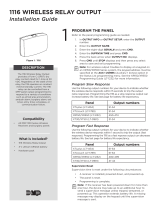 DMP Electronics 1116 Installation guide
DMP Electronics 1116 Installation guide
-
 DMP Electronics 1114 Installation guide
DMP Electronics 1114 Installation guide
-
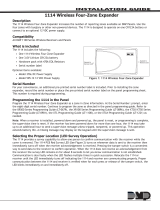 DMP Electronics 1114 Installation guide
DMP Electronics 1114 Installation guide
-
DMP Electronics 1118 Installation guide
-
DMP Electronics 1118 Installation guide
-
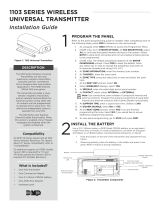 DMP Electronics 1103 Series Installation guide
DMP Electronics 1103 Series Installation guide
-
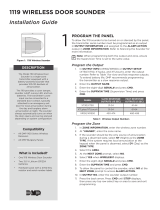 DMP Electronics 1119 Installation guide
DMP Electronics 1119 Installation guide
-
DMP Electronics 1100R Installation guide
-
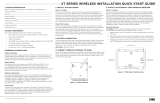 DMP Electronics XT Series Quick start guide
DMP Electronics XT Series Quick start guide
Other documents
-
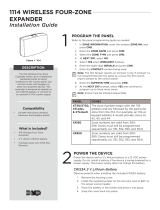 Digital Monitoring Products 1114 Four-Point Wireless Zone Expander Installation guide
Digital Monitoring Products 1114 Four-Point Wireless Zone Expander Installation guide
-
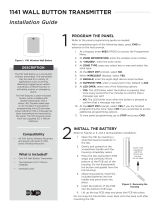 Digital Monitoring Products 1141 Wireless Wall Button Installation guide
Digital Monitoring Products 1141 Wireless Wall Button Installation guide
-
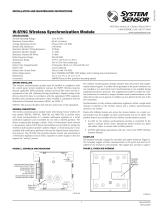 SILENT KNIGHT W-SYNC Wireless Synchronization Module User manual
SILENT KNIGHT W-SYNC Wireless Synchronization Module User manual
-
 Digital Monitoring Products 1154 Wireless Four-zone Input Module Installation guide
Digital Monitoring Products 1154 Wireless Four-zone Input Module Installation guide
-
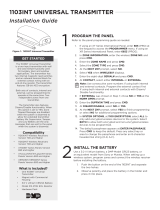 Digital Monitoring Products 1103INT Universal Transmitter Installation & Programming Guides
Digital Monitoring Products 1103INT Universal Transmitter Installation & Programming Guides
-
AJAX 9NA MotionProtect Plus Pet Immune Motion Detector User guide
-
AJAX 9NA HomeSiren User guide














